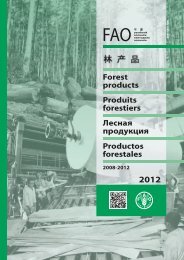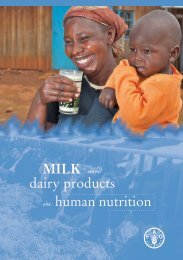XXIV NOTES ON THE TABLES Production and trade ROUNDWOOD Industrial Roundwood Data on industrial roundwood production are not available for a number of countries and have been estimated by converting the volume of products produced in the country to the volume of roundwood required to produce that volume (the roundwood equivalent). Consumption of individual forest products included in total industrial roundwood cannot be calculated due to the different definitions of forest products used in the production and trade statistics. In 1988 a number of countries that were members of the Customs Co-operation Council (now named the World Customs Organization) introduced a revised classification of products in their trade statistics, the Harmonized Commodity Description and Coding System (HS). This has also been adopted by the United Nations in Revision 3 of the Standard international trade classification (SITC Rev. 3). Although for most forest products this is a straightforward transformation from the previous classification, in the case of industrial roundwood the subdivisions between sawlogs and veneer logs, pulpwood and other industrial roundwood are not included. Thus tables for trade in these products are discontinued. The incomplete declaration of roundwood production data explains the presence of negative consumption in some countries (i.e. this is a statistical problem). These inaccuracies are included in the regional and world totals. Wood Fuel, including Wood for Charcoal, and Charcoal For many countries, wood fuel and charcoal production is not reported every year. Production of these products is believed to be significant in many of these countries and these statistics are required to calculate total roundwood production. Consequently, FAO estimates wood fuel and charcoal production. These estimates are now based on a statistical model relating wood fuel and charcoal consumption to a number of other variables. These variables include: population; income; the distribution of population between urban and rural locations; forest cover; oil production; temperature; and land area. Full details of the model used to produce these estimates can be found on the Global Forest Products Outlook Study webpages on the FAO website. In some countries, these new estimates vary greatly from those that were produced before. However, the model used to produce these new estimates is believed to produce more reliable estimates than were presented in the past. As in the past, production statistics that are estimated from this model rather than supplied by countries are identified with an ‘F’ in FAO’s statistical database (FAOSTAT). Value units The unit used in tables on the value of trade is US dollars. In the tables on unit value of trade, it is US dollars per cubic metre or per metric ton, according to the commodity. Country notes Certain countries either have not reported statistics to FAO or have reported only partially. In such cases, information has been taken from national yearbooks, from reports or from unofficial publications. Estimates of trade have been based on information provided by reports of trading partners. The following notes apply to particular countries: China Data include those for Taiwan Province of China, Hong Kong Special Administrative Region and Macau Special Administrative Region. Canada and the United States of America For Canada and the United States of America, the volume of sawnwood reported in 1 000 board feet is converted to cubic metres using a conversion factor of 2.36 m 3 per 1 000 bd ft. Sawing conventions in these countries generally result in the true volume of production being less than the nominal volume of production. Coniferous sawnwood data have been converted from nominal to actual by multiplying the nominal data with a 0.7203 conversion factor. Such conversions are identified with a ‘*’ in FAO’s Statistical database (FAOSTAT). Data for particle board production in the United States of America only includes OSB (oriented strand board) from 1995. WOOD-BASED PANELS Veneer Sheets For some countries, the reported volume of production of veneer sheets includes veneer sheets produced for plywood manufacture within the same country. FAO has attempted to correct these statistics wherever possible. Direction of trade Information on the direction of trade is reported for the latest two years. These tables are based on an analysis of information provided by countries on the joint forest products questionnaire and from data drawn from the COMTRADE database of the United Nations Statistics Division. Where volumes have not been reported in standard units, standard conversion factors have been applied. Where reported volumes have been inconsistent with value, volumes have been re-estimated on the basis of average unit values. In the absence of exporting country reports, estimates of their exports have been constructed from importers' reports. In this edition, volumes reported under direction of trade may differ somewhat from data shown in the main yearbook tables due to adjustments made on the basis of both COMTRADE and questionnaire information.
XXV Composition of Product Aggregates A G G R E G A T E S Roundw ood Roundw ood Roundw ood Wood Fuel, Industrial Industrial Industrial Saw logs Pulpw ood, Other Saw nw ood Wood-Based Fibreboard Wood Pulp Chemical Pulp for Total Paper Other Paper Forest (C) (NC) Including Wood Roundw ood-Wood Roundw ood-Wood Roundw ood-Wood and Round and Industrial Panels Wood Pulp Paper Fibre and and Products for Charcoal in the Rough in the Rough (C) in the Rough (NC) Veneer Logs Split Roundw ood Furnish Paperboard Paperboard Value Products Units CUM CUM CUM CUM CUM CUM CUM CUM CUM CUM CUM CUM CUM MT MT MT MT MT MT US$ P,I,E,C P P P,I,E,C P,I,E,C P,I,E,C P,I,E,C P P P P,I,E,C P,I,E,C P,I,E,C P,I,E,C P,I,E,C P,I,E,C P,I,E,C P,I,E,C P,I,E,C I,E Wood Fuel, including Wood for Charcoal (Trade) CUM i,e i,e i,e Wood Fuel, including Wood for Charcoal (C) CUM p p p Wood Fuel, including Wood for Charcoal (NC) CUM p p p Sawlogs and Veneer Logs (C) CUM p p p p p Sawlogs and Veneer Logs (NC) CUM p p p p p Pulpwood, Round and Split (C) CUM p p p p p Pulpwood, Round and Split (NC) CUM p p p p p Other Industrial Roundwood (C) CUM p p p p p Other Industrial Roundwood (NC) CUM p p p p p Industrial Roundwood-Wood in the Rough (C) CUM i,e i,e i,e i,e Industrial Roundwood-Wood in the Rough (NC) Tropical CUM i,e i,e i,e i,e Industrial Roundwood-Wood in the Rough (NC) Other CUM i,e i,e i,e i,e Wood Charcoal MT i,e Wood Chips and Particles CUM i,e Wood Residues CUM i,e Sawnwood (C) CUM p,i,e,c i,e Sawnwood (NC) CUM p,i,e,c i,e Veneer Sheets CUM p,i,e,c i,e Plywood CUM p,i,e,c i,e Particle Board CUM p,i,e,c i,e Hardboard CUM p,i,e,c p,i,e,c i,e Medium Density Fibreboard (MDF) CUM p,i,e,c p,i,e,c i,e Insulating Board CUM p,i,e,c p,i,e,c i,e Dissolving Wood Pulp MT p,i,e,c i,e Mechanical Wood Pulp MT p,i,e,c p,i,e,c p,i,e,c i,e Semi-Chemical Wood Pulp MT p,i,e,c p,i,e,c p,i,e,c i,e Unbleached Sulphite Pulp MT p,i,e,c p,i,e,c p,i,e,c p,i,e,c i,e Bleached Sulphite Pulp MT p,i,e,c p,i,e,c p,i,e,c p,i,e,c i,e Unleached Sulphate Pulp MT p,i,e,c p,i,e,c p,i,e,c p,i,e,c i,e Bleached Sulphate Pulp MT p,i,e,c p,i,e,c p,i,e,c p,i,e,c i,e Other Fibre Pulp MT p,i,e,c p,i,e,c i,e Recovered Paper MT p,i,e,c i,e Newsprint MT p,i,e,c i,e Printing and Writing Paper MT p,i,e,c i,e Household and Sanitary Paper MT p,i,e,c p,i,e,c i,e Wrapping and Packaging Paper and Paperboard MT p,i,e,c p,i,e,c i,e Other Paper and Paperboard Not Elsewhere Specified MT p,i,e,c p,i,e,c i,e Legend Notes: Aggregates Production (P) for an aggregate equals the sum of production for all of its elements identified with a (p) in the column. P=Production Import (I) for an aggregate equals the sum of import for all of its elements identified with an (i) in the column. I=Import Export (E) for an aggregate equals the sum of export for all of its elements identified with an (e) in the column. E=Export Consumption (C) for an aggregate is calculated only when data for production (P), import (I) and export (E) are available for that aggregate. C=Consumption (P+I-E) Consumption (c) for an element is calculated only when data for production (p), import (i) and export (e) are available for that product. Products Total import value (I) and total export value (E) equal the sum of import values (i) and export values (e) respectively identified in the column. p=production i=import e=export c=consumption (p+i-e)
- Page 1 and 2: yearbook annuaire eжегодник
- Page 3 and 4: 47 203 yearbook annuaire eжего
- Page 5 and 6: III 目 录 前 言 ...............
- Page 7 and 8: V 粮 农 组 织 林 产 品 年
- Page 9 and 10: VII 包 括 : 除 木 质 燃 料
- Page 11 and 12: IX 家 庭 用 纸 和 卫 生 纸
- Page 13 and 14: P= I = E= C= 出 产 进 消 p= I =
- Page 15 and 16: XIII 国 家 、 地 区 和 大
- Page 17: XV 编 制 产 量 和 贸 易 表
- Page 20 and 21: XVIII PULP AND RECOVERED PAPER Wood
- Page 22 and 23: XX SYMBOLS USED IN THE TABLES CUM C
- Page 24 and 25: XXII Hardboard Wet-process fibreboa
- Page 28 and 29: XXVI Products and Product Aggregate
- Page 30 and 31: XXVIII Computer-generated label Eng
- Page 33 and 34: XXXI TABLE DES MATIERES INTRODUCTIO
- Page 35 and 36: XXXIII ANNUAIRE FAO DES PRODUITS FO
- Page 37 and 38: XXXV d’autres parties de l’arbr
- Page 39 and 40: XXXVII PAPIERS ET CARTONS Papiers e
- Page 41 and 42: XXXIX Composition des agrégats de
- Page 43 and 44: XLI LISTE DES PAYS, ZONES ET CONTIN
- Page 45: XLIII COEFFICIENTS DE CONVERSION TY
- Page 48 and 49: XLVI МАССА И РЕКУПЕРИ
- Page 50 and 51: XLVIII Для улучшения э
- Page 52 and 53: L ПИЛОМАТЕРИАЛЫ Пил
- Page 54 and 55: LII Абсорбционная бу
- Page 56 and 57: LIV Композиция групп
- Page 58 and 59: LVI СПИСОК СТРАН, ЗОН
- Page 60 and 61: LVIII СТАНДАРТНЫЕ КОЭ
- Page 62 and 63: LX PASTA Y PAPEL RECUPERADO Pasta d
- Page 64 and 65: de alta calidad sobre producción y
- Page 66 and 67: de madera terciada, material de con
- Page 68 and 69: NOTAS SOBRE LOS CUADROS Producción
- Page 70 and 71: LXVIII Productos y agregados de pro
- Page 72 and 73: LXX Rótulo elaborado con computado
- Page 75 and 76: A-1 Exchange rates Taux de change
- Page 77 and 78:
A-3 2012 Five Leading Producing Cou
- Page 79 and 80:
A-5 2012 Five Leading Exporting Cou
- Page 81 and 82:
ROUNDWOOD BOIS ROND ÊÐÓÃËÛÉ
- Page 83 and 84:
3 Roundwood Bois rond Êðóãëû
- Page 85 and 86:
5 Roundwood Bois rond Êðóãëû
- Page 87 and 88:
7 Exports Roundwood Bois rond Êð
- Page 89 and 90:
9 Roundwood (C) Bois rond (C) Êð
- Page 91 and 92:
11 Roundwood (NC) Bois rond (NC) Ê
- Page 93 and 94:
13 Roundwood (NC) Bois rond (NC) Ê
- Page 95 and 96:
15 Wood Fuel, Including Wood for Ch
- Page 97 and 98:
17 Wood Fuel, Including Wood for Ch
- Page 99 and 100:
19 Wood Fuel, Including Wood for Ch
- Page 101 and 102:
21 Wood Fuel, Including Wood for Ch
- Page 103 and 104:
23 Industrial Roundwood-Wood in the
- Page 105 and 106:
25 Industrial Roundwood-Wood in the
- Page 107 and 108:
27 Industrial Roundwood-Wood in the
- Page 109 and 110:
29 Industrial Roundwood-Wood in the
- Page 111 and 112:
31 Industrial Roundwood-Wood in the
- Page 113 and 114:
33 Industrial Roundwood-Wood in the
- Page 115 and 116:
35 Industrial Roundwood-Wood in the
- Page 117 and 118:
37 Industrial Roundwood-Wood in the
- Page 119 and 120:
39 Industrial Roundwood-Wood in the
- Page 121 and 122:
41 Industrial Roundwood-Wood in the
- Page 123 and 124:
43 Industrial Roundwood-Wood in the
- Page 125 and 126:
45 Industrial Roundwood-Wood in the
- Page 127 and 128:
47 Sawlogs and Veneer Logs Grumes,
- Page 129 and 130:
49 Sawlogs and Veneer Logs (C) Grum
- Page 131 and 132:
51 Sawlogs and Veneer Logs (NC) Gru
- Page 133 and 134:
53 Pulpwood, Round and Split Bois d
- Page 135 and 136:
55 Pulpwood, Round and Split (NC) B
- Page 137 and 138:
57 Other Industrial Roundwood Autre
- Page 139 and 140:
59 Other Industrial Roundwood (NC)
- Page 141 and 142:
WOOD CHARCOAL, WOOD CHIPS, PARTICLE
- Page 143 and 144:
63 Wood Charcoal Charbon de bois Ä
- Page 145 and 146:
65 Exports Wood Charcoal Charbon de
- Page 147 and 148:
67 Wood Chips and Particles Plaquet
- Page 149 and 150:
69 Wood Residues Résidus de bois
- Page 151:
71 Exports Wood Residues Résidus d
- Page 154 and 155:
74 Sawnwood Sciages Ïèëîìàò
- Page 156 and 157:
76 Sawnwood Sciages Ïèëîìàò
- Page 158 and 159:
78 Sawnwood Sciages Ïèëîìàò
- Page 160 and 161:
80 Exports Sawnwood Sciages Ïèë
- Page 162 and 163:
82 Sawnwood (C) Sciages (C) Ïèë
- Page 164 and 165:
84 Sawnwood (C) Sciages (C) Ïèë
- Page 166 and 167:
86 Sawnwood (C) Sciages (C) Ïèë
- Page 168 and 169:
88 Exports Sawnwood (C) Sciages (C)
- Page 170 and 171:
90 Sawnwood (NC) Sciages (NC) Ïè
- Page 172 and 173:
92 Sawnwood (NC) Sciages (NC) Ïè
- Page 174 and 175:
94 Exports Sawnwood (NC) Sciages (N
- Page 177 and 178:
WOOD-BASED PANELS PANNEAUX À BASE
- Page 179 and 180:
99 Wood-Based Panels Panneaux à ba
- Page 181 and 182:
101 Wood-Based Panels Panneaux à b
- Page 183 and 184:
103 Wood-Based Panels Panneaux à b
- Page 185 and 186:
105 Wood-Based Panels Panneaux à b
- Page 187 and 188:
107 Veneer Sheets Feuilles de Placa
- Page 189 and 190:
109 Veneer Sheets Feuilles de Placa
- Page 191 and 192:
111 Plywood Contreplaqués Ôàíå
- Page 193 and 194:
113 Plywood Contreplaqués Ôàíå
- Page 195 and 196:
115 115 Plywood Contreplaqués Ôà
- Page 197 and 198:
117 Exports Plywood Contreplaqués
- Page 199 and 200:
119 Particle Board Panneaux de part
- Page 201 and 202:
121 Particle Board Panneaux de part
- Page 203 and 204:
123 Fibreboard Panneaux de fibres
- Page 205 and 206:
125 Fibreboard Panneaux de fibres
- Page 207 and 208:
127 Fibreboard Panneaux de fibres
- Page 209 and 210:
129 Hardboard Durs Òâåðäûå
- Page 211 and 212:
131 Hardboard Durs Òâåðäûå
- Page 213 and 214:
133 Medium Density Fibreboard (MDF)
- Page 215 and 216:
135 Medium Density Fibreboard (MDF)
- Page 217 and 218:
137 Medium Density Fibreboard (MDF)
- Page 219 and 220:
139 Insulating Board Panneaux fibre
- Page 221 and 222:
141 Insulating Board Panneaux fibre
- Page 223 and 224:
PULP AND RECOVERED PAPER PÂTE ET V
- Page 225 and 226:
145 Wood Pulp Pâte de bois Äðå
- Page 227 and 228:
147 Wood Pulp Pâte de bois Äðå
- Page 229 and 230:
149 Mechanical Wood Pulp Pâte de b
- Page 231 and 232:
151 Mechanical Wood Pulp Pâte de b
- Page 233 and 234:
153 Semi-Chemical Wood Pulp Pâte d
- Page 235 and 236:
155 Chemical Wood Pulp Pâte de boi
- Page 237 and 238:
157 Chemical Wood Pulp Pâte de boi
- Page 239 and 240:
159 Exports Chemical Wood Pulp Pât
- Page 241 and 242:
161 Unbleached Sulphite Pulp Pâte
- Page 243 and 244:
163 Bleached Sulphite Pulp Pâte bl
- Page 245 and 246:
165 Bleached Sulphite Pulp Pâte bl
- Page 247 and 248:
167 Unbleached Sulphate Pulp Pâte
- Page 249 and 250:
169 Bleached Sulphate Pulp Pâte bl
- Page 251 and 252:
171 Bleached Sulphate Pulp Pâte bl
- Page 253 and 254:
173 Bleached Sulphate Pulp Pâte bl
- Page 255 and 256:
175 Dissolving Wood Pulp Pâte de b
- Page 257 and 258:
177 Other Fibre Pulp Pâte, autres
- Page 259 and 260:
179 Other Fibre Pulp Pâte, autres
- Page 261 and 262:
181 Recovered Paper Vieux papiers
- Page 263 and 264:
183 Recovered Paper Vieux papiers
- Page 265 and 266:
PAPER AND PAPERBOARD PAPIER ET CART
- Page 267 and 268:
187 Paper and Paperboard Papiers et
- Page 269 and 270:
189 Paper and Paperboard Papiers et
- Page 271 and 272:
191 Paper and Paperboard Papiers et
- Page 273 and 274:
193 Exports Paper and Paperboard Pa
- Page 275 and 276:
195 Newsprint Papier journal Ãàç
- Page 277 and 278:
197 Newsprint Papier journal Ãàç
- Page 279 and 280:
199 Printing and Writing Paper Papi
- Page 281 and 282:
201 Printing and Writing Paper Papi
- Page 283 and 284:
203 Printing and Writing Paper Papi
- Page 285 and 286:
205 Other Paper and Paperboard Autr
- Page 287 and 288:
207 Other Paper and Paperboard Autr
- Page 289 and 290:
209 Other Paper and Paperboard Autr
- Page 291 and 292:
211 Household and Sanitary Paper Pa
- Page 293 and 294:
213 Household and Sanitary Paper Pa
- Page 295 and 296:
215 Wrapping and Packaging Paper an
- Page 297 and 298:
217 Wrapping and Packaging Paper an
- Page 299 and 300:
219 Other Paper and Paperboard Not
- Page 301 and 302:
221 Other Paper and Paperboard Not
- Page 303:
223 Other Paper and Paperboard Not
- Page 306 and 307:
226 Forest Products Produits forest
- Page 308 and 309:
228 Forest Products Ëåñíûå ò
- Page 310 and 311:
230 Industrial Roundwood-Wood in th
- Page 312 and 313:
232 Industrial Roundwood-Wood in th
- Page 314 and 315:
234 Sawnwood (C) Sciages (C) Ïèë
- Page 316 and 317:
236 Veneer Sheets Feuilles de placa
- Page 318 and 319:
238 Particle Board Panneaux de part
- Page 320 and 321:
240 Wood Pulp Pâte de bois Äðå
- Page 322 and 323:
242 Paper and Paperboard other than
- Page 324 and 325:
Sales and Marketing Group, Communic
- Page 327 and 328:
á`«Hô©dG ¿Gó∏`ÑdG ‘ á`
- Page 329 and 330:
xxviii الوحدة بوةة 0 قد
- Page 331 and 332:
xxvi Computer-generated label Thail
- Page 333 and 334:
xxiv املنتجات اخلشب ا
- Page 335 and 336:
xxii االمسي يف معامل
- Page 337 and 338:
xx م حظات عل اجلداول
- Page 339 and 340:
xviii على هيئة ةحائف أ
- Page 341 and 342:
xvi وفى الف:ة التى سب
- Page 343 and 344:
xiv م . الشظايا واحلب
- Page 345 and 346:
xii جمموعات املنتجات
- Page 347 and 348:
x الرموز املستخدمة
- Page 349 and 350:
viii وتتضمن اجلداول ا
- Page 351 and 352:
vi 214.............................
- Page 353 and 354:
iv 011......................... أ
- Page 355 and 356:
ISBN 978-92-5-008287-5 ISSN 1020-45
- Page 357 and 358:
ISBN 978-92-5-008287-5 ISSN 1020-45







